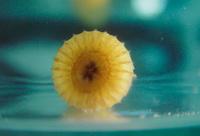Antarctic sea bottom
2005/09/01 Andonegi Beristain, Garazi - Elhuyar Zientziaren Komunikazioa Iturria: Elhuyar aldizkaria
Sea of Bellingshausen
The oceanographic ship Hesperides will work in the sea of Bellingshausen. The weather conditions in this sea are very hard, so very few studies have been carried out. At the same time, this means that it has been out of human influence.

In this case, the scientists of the expedition will analyze the seabed, up to 2.000 m of depth, using for it trailers in closed network and lead dredges.
Both methods are complementary. With the trawling net the marine bottoms are combed and all the species that live there are collected in revolt.
On the contrary, the lead draga is projected on the bottom of the sea and when it collides with the bottom it takes a 50 x 50 cm sample. This sample is quantified, that is, you can calculate the number of species per square meter, biomass, etc.
Once these samples arrive to the boat, the mud is cleaned and classified in groups or filums such as sponges, corals, polychetes, molluscs, echinoderms, fish, etc. Still alive, photos are taken and, finally, they are put in alcohol or formaldehyde to take them to the laboratories.
To classify a new species
The distribution begins when the animals reach the pier. Specifically, Leioa receives two groups of worms or marine vermes to carry out taxonomic studies.
The objective of these taxonomic studies is the identification of species, that is, if it is a new or already described species. For this purpose, an exhaustive analysis of the external and internal anatomy of the animal is performed, using magnifier and microscope. Note that the size of these animals ranges from 1 to 150 mm.
In the laboratory itself, more photos are taken to identify some special characteristic and finally its classification is proposed in journals specialized in marine zoology.
In fact, after the discovery of a new species of vermes in the previous campaign, the researcher of Leioa will propose at the end of the studies the name of the species and its morphological characteristics for the scientific communicant to accept it.
Therefore, the studies of biodiversity in marine bottoms offer, although progressively, interesting results. We would like it not to be too late, as many experts believe that many species are disappearing before they know them.



